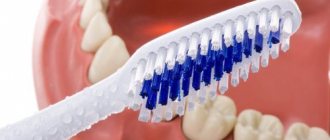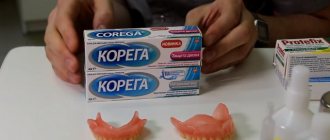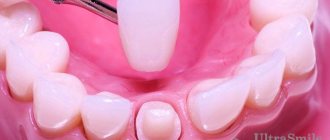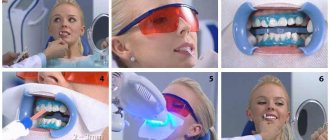Content
- Causes
- What to do if a crown falls out
- What can't you do?
- What to do if you can’t see a doctor right away
- What will the doctor do?
- How to prevent hair loss
The use of modern high-quality and high-tech materials does not make the service life of crowns unlimited. A dental crown has a specific lifespan of 12 years. Sometimes it happens that the crown falls out. Immediately after this trouble, increased sensitivity of the stump may appear. Contact your doctor without delay. If this is not possible, follow your doctor’s recommendations to save the tooth and reduce discomfort as much as possible.
Content:
- Why do crowns fall out?
- When can the prosthesis be returned?
- When it is impossible to return a fallen prosthesis to its place 3.1. Loss of prosthesis with stump or pin 3.2. It is necessary to re-treat the dental canals 3.3. Loss along with natural root
- General recommendations in case of crown loss
- Preventing the problem from occurring
In dental practice, situations sometimes occur when a crown falls off.
Having realized what happened, the patient usually experiences fear. He experiences a state of panic, as he fears that it will no longer be possible to restore the repeatedly destroyed unit. No need to worry too much. The first thing you need to do is urgently seek qualified dental care. The doctor will assess the condition of the stump and the fallen prosthesis and tell you whether everything can be returned to its place.
Why is this happening
The following reasons for loss are possible:
- The service life of the cement has expired, the composition has lost its fastening properties - the crown has decemented;
- The patient put too much stress on the crown by including hard foods in the menu;
- During installation, temporary cement was used, which had to be replaced at the appointed time;
- A destructive process was underway under the crown - caries developed, as a result, the tightness of the connection was broken;
- The person often consumed chewing candies and toffees - the viscous consistency of the products contributed to the tearing of the crown from the tooth;
- The crown was placed on a tooth that was too small, and the insufficient tooth height reduced the bond;
- The size of the crown exceeded the size of the stump;
- The tooth stump turned out to be pointed, so the crown was weakly fixed;
- The material used to make the prosthesis was not strong enough.
PROMOTION
Installation of crowns, dental bridge
RUB 3,450
When it is impossible to return a fallen denture to its place
Unfortunately, in most clinical cases it is not possible to glue the crown back. This is due to the fact that after re-fixation it no longer fits tightly to the stump, which means that food debris will constantly get clogged under it. Soft tissues will often begin to become inflamed - conditions will be created for the destruction of the dentogingival apparatus.
A product that has fallen off cannot be returned if:
- it fell out along with the pin or stump;
- there are indications for repeated filling of the root canals of the exposed unit;
- it fell out along with the natural root.
Let's look at each limitation in more detail.
Loss of prosthesis with stump or pin
This is possible if:
- at the stage of preparation for prosthetics, the doctor did not notice that the walls of the roots were very thin and fragile;
- the process of preparation for restoring the integrity of the dentition is disrupted;
- the adhesive base has disintegrated;
- After fixation of the prosthesis, the chewing load was distributed unevenly.
Helpful information . Today, dentists are trying to use inlays rather than pins. These structures are identical in their functions. But the pins can provoke deformation of the root and necrosis of the tissues located near it.
If the crown and the inlay/pin fall out, it is advisable to visit a doctor on the same day. If you ignore the problem, pathogenic organisms may begin to multiply in the opened area. They can spread to the jaw bones. Then the therapy will be long and complex.
It is necessary to re-treat dental canals
Quite often, the product falls out due to a progressive inflammatory process in the root canals. Then the stump ceases to fit tightly to the walls and becomes mobile. Following this, the prosthesis begins to wobble.
Detecting the inflammatory process is not difficult - it is clearly visible on an x-ray. To remove it, the doctor performs repeated cleaning of the roots. Then, according to the new parameters, a suitable orthopedic system is manufactured.
It also happens that hard tissues are in unsatisfactory condition. Then they are further reinforced with a tab. If it turns out that the root is cracked or partially destroyed, there is only one way out - removal.
Loss along with natural root
Sometimes the entire unit falls out, that is, the separation of the artificial crown part from the natural roots does not occur. This happens when:
- cyst;
- granuloma;
- periodontal pathologies.
It is clear that here we can no longer talk about any restoration measures. The doctor takes a picture and examines whether there are any root remains in the soft tissues. If necessary, remove them surgically.
To close the void that appears in the dentition, the specialist suggests implanting a pin and subsequent fixation of the implant or making a dental bridge. In any case, the defect should be closed as quickly as possible, as it can lead to malocclusion and atrophy of hard jaw tissues.
What to do if it is not possible to see a doctor immediately
- Apply clove oil to the tooth and the pain will decrease.
- Wash the crown and install it on the tooth using cement, which is sold in the pharmacy chain. It is not advisable to do this, but if you contact your dentist and get the go-ahead, you can fix the product temporarily, according to the recommendations of a specialist. You should first rinse your mouth with an antiseptic.
- If necessary, you can take painkillers.
- If the crown falls off and cannot be found, you can simply lubricate the tooth with pharmaceutical cement - this technique will somewhat reduce the discomfort.
Preventing the problem from occurring
To reduce the likelihood of dental structures falling out, you should:
- Be treated only in a trusted medical center. Particular attention should be paid to the doctor’s qualifications and work experience. There is no need to look for cheap dentures in the city - price should be the last criterion when it comes to oral health. Main quality.
- Follow all medical prescriptions. Usually the doctor explains in detail how to extend the life of the system. His recommendations should be kept in mind.
- Treat the artificial unit with care. It is unacceptable to chew nuts, foreign objects, open bottles with your teeth, etc.
- Follow the rules of oral hygiene. It is recommended that the crown, like the natural teeth surrounding it, be cleaned with toothpaste and a brush at least twice a day. It is impossible for plaque to be deposited on its surface and stone to form.
- Have preventive dental examinations annually. During them, the doctor examines the condition of the oral cavity and takes measures to prevent the development of dental diseases.
Take care of your teeth. Then your smile will remain beautiful for many years.
Possible options
If the old crown can be used, it will be reinstalled using fresh temporary dental cement. The patient will have the opportunity to wear the crown again for some time; if discomfort does not arise, the fixation will be performed with permanent cement. If wearing it is impossible, the dentist will offer to make a new crown and give reasons for his recommendations.
Minor damage to the crown (chips) can be repaired. Significant damage cannot be repaired. A new product will need to be manufactured.
When can the prosthesis be returned?
Sometimes the fallen protection can be returned to the oral cavity. So, it’s possible to correct the situation if:
- the stump is not damaged or affected by caries;
- The “cap” remains intact, there are no cracks, chips or scratches on it.
Then the doctor carries out an antiseptic treatment of the base and removes any remaining glue from its surface. Then the structure is re-fixed with dental cement.
It is important not to delay visiting a specialist. The prepared unit covered by the prosthesis is always very fragile. It is not able to withstand the chewing load. If you don't cover it in time, it will most likely break. Then you will have to carry out prosthetics from the very beginning or, even worse, remove the roots and carry out implantation.
Cement in dentistry?
Cement is usually called a specific material with a powdery consistency, which, when interacting with a certain amount of water, can change its consistency. At first it becomes viscous, dough-like. Further, under the influence of air, its crystallization occurs, and the cement turns into a solid.
Zinc oxide
Cements for fixing dental crowns are divided into temporary and permanent. The most common among them is zinc phosphate cement. It consists of liquid and powder. The basis of this material is zinc oxide. It contains silicon and magnesium oxide. The liquid is a specific solution of water, phosphoric acid, zinc phosphate and aluminum. To prevent the reaction of the powder with the liquid from occurring too quickly, metal salts are added to such cements. The speed of the reaction depends on the amount of water in the liquid.
Relationship between loss and service life
Dental bridges can fall out due to natural wear and tear or the end of their life. On average it is 5 years. And with good oral hygiene and careful treatment, the bridge will last up to 10 years. If the bridge is supported by implants, the service life increases. For ceramic and metal-ceramic it is at least 10 years, and for zirconium dioxide and ceramic-composite – from 20 years.
“My mother built golden bridges for herself back in the 90s. So, they stayed with her for almost 20 years. Either the doctor was such a good one, or she was taking care of her teeth. But she definitely never ate nuts. And I installed metal-ceramic ones in 2014. And they fell out after only 6 years. The doctor was able to glue them in place, but I understand that it is no longer so convenient. We'll probably have to change it."
Anastasia G., review from gidpozubam.ru
Terms of use
A dental crown can solve the problem of tooth loss, but it can fall out at any time. In this case, glue will help, but it must be used correctly so as not to harm yourself. To do this, follow the instructions for use:
- The fallen denture must be cleaned of food, plaque and old glue. Use dental floss or a brush for cleaning. If cleaning is performed above the sink, you must first plug the drain hole so as not to lose the crown.
- Then you need to brush your teeth, especially the one from which the crown was removed. Unpleasant sensations may appear, since the tooth has been ground down and will be very sensitive. This phenomenon is considered normal. Don't press it too hard. It is desirable that the brush has soft bristles.
- The cleaned crown and tooth must be dried. Sterile gauze is used for this purpose. A bandage is suitable instead. You should wipe the surface of the tooth and crown carefully to avoid any unpleasant sensations.
- A small amount of glue is applied to the crown and then installed in the desired location. During the entire process, it is necessary to monitor actions through the mirror. This makes the work much easier. If the crown was in a hard-to-reach area, the procedure must be performed with someone's help.
- After installing the crown, you need to slightly clench your jaws. This is necessary to determine whether the prosthesis is installed in the desired position. This position must be held for 1-2 minutes until the glue dries. The wait may be less, it all depends on the means.
- Using dental floss, you need to carefully remove any remaining adhesive from your teeth. It is important that the movements are smooth and not forceful so that the crown does not fall out. This completes the procedure.
Glue selection
Depending on the individual characteristics of the patient, the doctor may prescribe a specific adhesive for dental crowns. But you can choose the remedy yourself, testing different options. This is how their quality is checked and sensations are observed. As a result, a suitable option will remain.
There are 3 types of dental crown adhesives produced by pharmaceutical companies:
- Viscous.
- Medium viscosity.
- Liquid.
The latter option costs more, but is more often chosen by people who have recently had crowns installed. The reason for this is ease of use. But gradually many people acquire viscous compositions, since liquid ones take a long time to dry.
Patients do not immediately get used to wearing a prosthesis, so in the first time after installation, changes in the perception of taste may be noticeable. In order not to aggravate the situation, experts advise not to use products with fragrances until you become accustomed to the foreign body.
Some manufacturers confidently believe that their products provide fixation for half a day, and sometimes more. But there are factors due to which the duration of fixation is noticeably reduced. This arises from laughter, food composition, food consumption. According to statistics, almost every crown adhesive lasts no more than 9 hours. this indicator varies depending on the quality of the product.
Recommendations
If you follow safety measures, you will be able to prevent the occurrence of side effects:
- The glue can be used after your doctor's permission.
- It is important to follow the instructions.
- The product should be stored out of the reach of children.
- Water should not get inside the package.
- The glue is stored with the cap closed and at room temperature.
Thanks to simple rules, it will be possible to protect the body from adverse consequences. If stored incorrectly, its service life will noticeably decrease, so you will need to buy a new product.
What to do if a temporary bridge falls out
If the temporary bridge falls out, then there is nothing to worry about. After all, it is glued to temporary cement, which has weaker fixing properties. Therefore, you need to contact an orthopedist to glue the structure in place. Or, if a permanent prosthesis is already ready or the implants have taken root, then the temporary bridge will not be put back, but the permanent one will be fixed immediately.
Complex on 4 OSSTEM implants with delayed loading - from RUB 170,000.
Complex implantation Osstem (South Korea) with delayed loading after 4-6 months.
Guarantee for the doctor’s work - unlimited Call now or order a call
Opening hours: 24 hours a day - seven days a week











